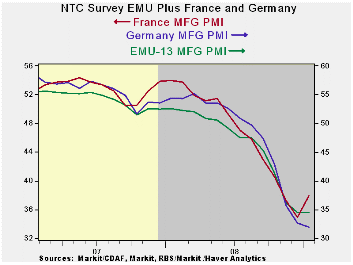 Global| Feb 02 2009
Global| Feb 02 2009MFG PMIs Stop Their Descent
Summary
The PMIs for Europe reside very near the bottom of their respective ranges. Generally the readings are bottom 10% of range or less across large EMU members and the UK. Germany is now one of the relative weakest countries on this [...]

The PMIs for Europe reside very near the bottom of their
respective ranges. Generally the readings are bottom 10% of range or
less across large EMU members and the UK. Germany is now one of the
relative weakest countries on this measure – it is at its range low
point. Germany is one of four countries to see its MFG PMI drop further
in January.
PMIs: what they are:
PMIs are super sensitive gauges of activity. And they usually detect
turning points in a sector before more convention indicators do. The
MFG PMIs have only just stopped their declining ways for the EMU
region; for several countries the bottom has not yet been hit (as far
as we know). Even for those that have rebounded this month we do not
know with any degree of confidence that they have firmly put their past
low point behind them for the duration of this cycle.
Too soon for the end?
It is too soon to call this a turning point signal. But the first step
to getting to a turning point is to build a base that signals that the
PACE OF decline has bottomed out. Remember that these are diffusion
indices and even if they move ‘sideways’, as long as the value is below
50 it is signaling further declines in the sector they measure. Also
recall that PMIs are formally indicators of the breadth of a decline or
the breadth of an increase in industry; they are not indicators of
STRENGTH.
What about the beginning of the end?
It may also be too soon to look even for bottoming, but it may also be
that such a bottoming process has begun. The levels of the PMIs are
extremely low, and that is the sort of pace we would expect a true
stabilization process to begin at in a cycle such as this. We know MFG
is hard-hit so unless the PMIs reached very low readings we would
continue to think that worse results would still lay ahead. Now that a
first criterion for stabilization has been met (new all-time lows or
readings near to that) we can look for a second, namely a period of
time in which the PMIs either make modest gains or establish a base by
moving sideways. The final step would be for them to rise and
eventually to poke their heads above the level of 50. That one is still
quite a way off.
| NTC/Markit MFG Indices | |||||||
|---|---|---|---|---|---|---|---|
| Jan-09 | Dec-08 | Nov-08 | 3Mo | 6Mo | 12Mo | Percentile | |
| Euro-13 | 34.42 | 33.88 | 35.58 | 34.63 | 39.58 | 44.98 | 2.1% |
| Germany | 31.96 | 32.66 | 35.66 | 33.43 | 40.03 | 46.69 | 0.0% |
| France | 37.90 | 34.91 | 37.28 | 36.70 | 39.91 | 45.34 | 10.1% |
| Italy | 36.06 | 35.54 | 34.95 | 35.52 | 39.62 | 43.86 | 4.9% |
| Spain | 31.51 | 28.49 | 29.42 | 29.81 | 34.12 | 38.89 | 10.5% |
| Austria | 33.12 | 35.01 | 38.26 | 35.46 | 40.74 | 45.43 | 0.0% |
| Greece | 39.98 | 40.96 | 42.25 | 41.06 | 45.77 | 49.44 | 0.0% |
| Ireland | 38.94 | 37.87 | 37.10 | 37.97 | 40.36 | 43.00 | 10.1% |
| Netherlands | 36.29 | 38.42 | 38.71 | 37.81 | 42.80 | 46.99 | 0.0% |
| EU | |||||||
| UK | 35.78 | 34.91 | 34.48 | 35.06 | 38.64 | 43.65 | 6.0% |
| percentile is over range since March 2000 | |||||||
Robert Brusca
AuthorMore in Author Profile »Robert A. Brusca is Chief Economist of Fact and Opinion Economics, a consulting firm he founded in Manhattan. He has been an economist on Wall Street for over 25 years. He has visited central banking and large institutional clients in over 30 countries in his career as an economist. Mr. Brusca was a Divisional Research Chief at the Federal Reserve Bank of NY (Chief of the International Financial markets Division), a Fed Watcher at Irving Trust and Chief Economist at Nikko Securities International. He is widely quoted and appears in various media. Mr. Brusca holds an MA and Ph.D. in economics from Michigan State University and a BA in Economics from the University of Michigan. His research pursues his strong interests in non aligned policy economics as well as international economics. FAO Economics’ research targets investors to assist them in making better investment decisions in stocks, bonds and in a variety of international assets. The company does not manage money and has no conflicts in giving economic advice.






